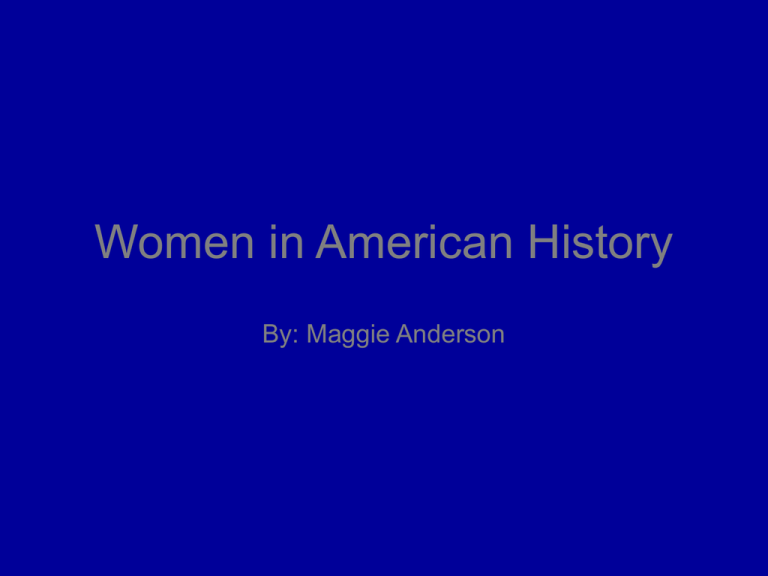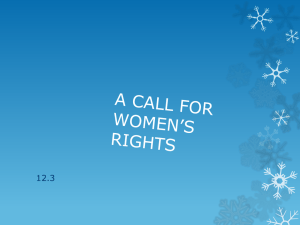Black American History
advertisement

Women in American History By: Maggie Anderson How have women struggled to have their unalienable rights recognized? For a long time people thought that women (and black people) were lower than men. Therefore they only let white men own property. Or vote, or hold a position in government. They weren’t paid as much as men if they worked. Women were expected to stay home to clean, cook, and raise children. Lots of women didn’t like that idea. Women can now own property, vote, and hold a position in government. How has the federal government responded to these struggles? The government kind of ignored the people fighting for women’s rights at first. Then they became to loud to ignore. The government didn’t like it, but their were to many people arguing for women’s rights, so the government gave in. How can current civil rights activists learn from past successes and failures? They can learn what to do, if it worked and what not to do if it failed! Susan B. Anthony Susan B. Anthony was a rights activist who focused on women's suffrage. She was a very dedicated to this cause, but also campaigned against slavery. She became an activist in 1852. Helen Keller Helen Keller was born blind and deaf. But that didn't stop her from expressing her thoughts and feelings about women's suffrage. In 1924 she openly advocated women's suffrage and argued against child labor, and capital punishment. She also strongly supported the NAACP, or National Association for the Advancement of Colored People. Elizabeth Stanton Elizabeth Stanton played a major role in the fight for women suffrage. She spoke at the First Women’s Rights Convention in 1848, which she helped organize. Unlike many others involved, who mainly addressed voting issues, she addressed women's parental and custody rights, property rights, employment and income rights,and divorce. Lucretia Mott Lucretia Mott was a woman who was very involved in women's suffrage. She attended the First Women’s Rights Convention in 1848 and the world Anti-Slavery Convention in London with Elizabeth Stanton in 1840. Lucretia Mott is the sister of Martha Coffin Wright. Both of them and Elizabeth Stanton organized the 1848 Martha Coffin Wright Martha Coffin Wright also attended the First Women’s Rights Convention in 1848. She now has a statue where it took place, in Seneca Falls. Elizabeth Stanton and Lucretia Mott also have statues there. Mary Ann M'Clintock Mary Ann M'Clintock was a women's activist who, along with Lucretia Mott, the Grimke sisters, and many others, formed The Philadelphia Female AntiSlavery Society or PFASS. The Grimke Sisters The Grimke Sisters lectured against slavery in America in the 1800s. People ridiculed them for being women abolitionists. They quickly became activists in the women's rights movement. The Grimke Sisters also helped found the PFASS. Citations • http://www.utne.com/Politics/Helen-Keller-Political-Leftist-Radical.aspx • http://susanbanthonyhouse.org/her-story/biography.php • http://en.wikipedia.org/wiki/Elizabeth_Cady_Stanton • http://www.quakersintheworld.org/quakers-in-action/183 • http://www.nps.gov/wori/historyculture/mary-ann-mclintock.htm • http://womenshistory.about.com/cs/suffrage/a/martha_wright.htm • http://en.wikipedia.org/wiki/Grimk%C3%A9_sisters







![womens_rights[1]](http://s2.studylib.net/store/data/010014890_1-dbb1785f178ee376274698e7007ca41f-300x300.png)


